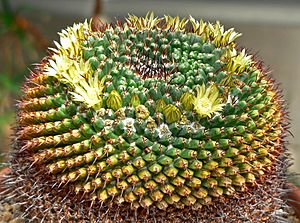Mammillaria gigantea facts for kids
Quick facts for kids Mammillaria gigantea |
|
|---|---|
 |
|
| Conservation status | |
| Scientific classification | |
| Genus: |
Mammillaria
|
| Species: |
gigantea
|
Mammillaria gigantea is a fascinating type of cactus that grows naturally in Mexico. Its name, "gigantea," means "giant" because it can grow quite large compared to other cacti in its family. This plant is part of the Cactoideae group, which includes many well-known cacti.
Contents
What is Mammillaria gigantea?
Mammillaria gigantea is a unique plant known for its size. Like most cacti, it has special ways to store water. This helps it survive in dry places. It belongs to the Mammillaria genus, which is a large group of cacti. These plants often have small bumps called tubercles. Flowers and fruits grow from these bumps.
Appearance of the Giant Cactus
This cactus usually grows as a single, rounded stem. Sometimes, it might have a few branches. Its stem can be quite wide, making it look very strong. The surface of the cactus is covered in many small, cone-shaped bumps. These bumps are called tubercles.
Each tubercle has a small, woolly area at its tip. This area is called an areole. Sharp spines grow from these areoles. The spines help protect the cactus from animals. They also help collect moisture from the air. The color of the spines can vary. They might be yellowish or brownish.
Flowers and Fruits
Mammillaria gigantea produces beautiful flowers. These flowers usually appear in a ring around the top of the plant. They can be various colors, often yellow or cream. After the flowers bloom, they turn into small, red fruits. These fruits are often edible. They contain tiny seeds. These seeds are how the cactus makes new plants.
Where Does It Live?
Mammillaria gigantea is native to Mexico. It grows in dry, rocky areas. These areas are often called deserts or semi-deserts. The climate there is usually very hot and sunny. There is not much rainfall.
Adapting to Dry Climates
Cacti like Mammillaria gigantea are experts at living in harsh conditions. They have special features that help them survive. Their thick stems store a lot of water. Their waxy skin helps prevent water from evaporating. The spines also help shade the plant. This reduces water loss.
Their roots spread out close to the surface. This helps them quickly soak up any rain that falls. These adaptations allow the cactus to thrive where other plants cannot.
Life Cycle and Reproduction
The life cycle of Mammillaria gigantea starts with a tiny seed. If a seed lands in a good spot, it will sprout. It then slowly grows into a mature cactus. This process can take many years.
How New Cacti Are Made
Mammillaria gigantea mainly reproduces using seeds. Insects or other animals might help pollinate its flowers. Pollination is when pollen is moved from one flower to another. This leads to the creation of seeds.
Once the fruits ripen, they can be eaten by birds or other animals. The animals then spread the seeds in their droppings. This helps the cactus grow in new places. Sometimes, new small plants, called offsets, might grow from the base of the main cactus. These offsets can also grow into new plants.
Conservation Status
The International Union for Conservation of Nature (IUCN) studies plants and animals. They check if species are at risk of disappearing. Mammillaria gigantea is currently listed as "Data Deficient" (DD).
What "Data Deficient" Means
"Data Deficient" means there isn't enough information. Scientists need more research to know if the species is truly endangered. It doesn't mean the plant is safe. It just means we don't have enough facts yet. More studies are needed to understand its population and threats. This helps protect the cactus for the future.
See also
 In Spanish: Mammillaria gigantea para niños
In Spanish: Mammillaria gigantea para niños


